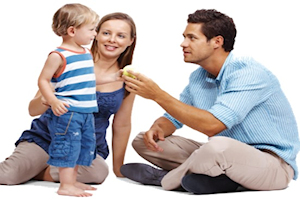- Remember to speak to your child in the language you feel most comfortable in; this helps you provide a better language model for your child.
- Make sure you have your child's attention before giving them an instruction.
- On occasions when your child has not understood, repeat the instruction and physically show them what you mean.
- When exploring new verbs, carry out the actions and make it fun.
- Encourage your child to ask for help or ask what a word means if they have not understood.
- Sharing books and rhymes are fun ways to explore the meaning of new words together.
Early Understanding

Key Fact 1: Children learn language from face to face interactions
Key Fact 2: They learn to talk from their parents and carers the most
Some children learn words quickly. Other children need the same word repeated lots of times. It is therefore important for children to hear new words many times in different situations to help them learn the word well.
There are different types of words that children learn to understand, for example:
Nouns (naming words)
Verbs (doing words)

Concepts and describing words
Concepts and describing Words
Describing words are words like colours (red, green, yellow, etc), size (big/small), shape (round, square, etc).
Concepts are words like fast/slow, up/down, same/different, short/long, hard/soft, rough/smooth, first/last, before/after, and preposition words like in, on, under, next to, in front of, behind, between.
How to help your child understand early words
Top Tips
What can I do to support my child's early understanding
The best way for children to learn the meaning of words is for them to hear them used often, in many different situations, to build their understanding. As a parent you can:
- Look to see what your child is interested in. They are more likely to learn the meaning of a word if it links to something they are playing with, motivated by, or interested in.
- Comment on what they are interested in. Remember to use not only nouns, but verbs and concepts/describing words when commenting. Try not to ask questions when children are in the early stages of language learning – they don’t have the language to answer yet (that comes later!)
- Keep language fairly simple – it’s important for children to hear lots of words but if you use too many words at once, your child might struggle to pick out the key words. Start with short phrases (e.g. ‘It’s a car!’) and build up.
- Use language as part of your everyday routines. As your child is getting dressed, talk about which piece of clothing they are putting on, include colours and patterns (spotty, stripy), talk about the order you are putting the clothes on (first we’ll put your socks on, then we’ll put your shoes on). You can do this with all routines at home: cleaning teeth, making breakfast, cooking dinner. Just talking through what’s happening and what you are doing ensures your child hears lots of words and helps them begin to understand the language of time and sequence (for example, first, next, last).
- Use objects or pictures to support your child’s understanding of routines and instructions at home, e.g. ‘it’s time for a bath’ and hold up a picture of a bath, or something that represents the bath, such as a bath towel, or a rubber ducky toy. If used every day, your child will start to understand what these words mean.
- Use gesture and facial expression to help build understanding and engagement. Arms spread wide when saying, ‘big!’ helps a child understand the word.
- Remember – children need to hear new words many, many times to learn them.
- It also helps to link new words with what your child already knows, as this makes it easier to learn the new word. Use new words in situations your child is already familiar with.

Further Resources
BBC Tiny Happy People – Key talking tips by age
This page offers a set of helpful tips to support language learning at home. There are also ideas of activities you can use with your child in everyday chat and play.
NHS Learning to Talk
This page offers advice and activities for helping children from 0 to 5 years to learn to talk, including advice on learning more than one language.
Hanen Language - Tips for Parents of Young Children
This page offers tips for communicating with children with or without words.
Concept Cat – This video offers helpful examples of teaching your child concept words, such as "small".

